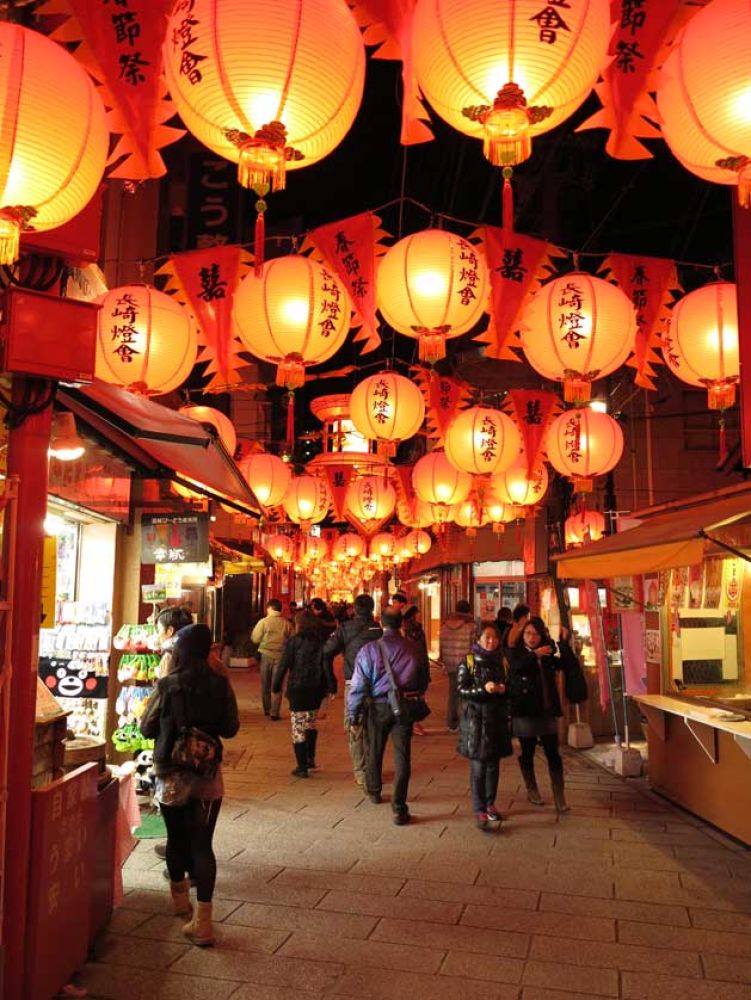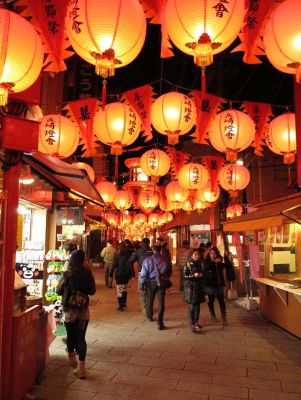

The Lunar New Year Celebration in Nagasaki Chinatown, also known as Nagasaki Shinchi Chinatown, is one of the area's most vibrant and joyous events. Visitors come from far and wide to experience the festive atmosphere that fills the streets. The celebration, which marks the beginning of the Chinese lunar calendar, features an explosion of color with traditional decorations, red lanterns, and banners adding charm to the narrow thoroughfares. Dragon dances, lion dances, and other cultural performances add to the spectacle, while the air is filled with the scent of delicious Chinese cuisine. Food stalls and local restaurants offer an array of authentic dishes, such as champon and Sara udon, attracting food enthusiasts. Exploring the market stalls that sell a variety of Chinese-themed gifts, souvenirs, and traditional crafts is a delightful experience. The lively event provides visitors an immersive cultural experience and a deeper appreciation for the rich Chinese heritage that has influenced Nagasaki over the centuries.
While visiting Nagasaki Chinatown, take a short walk to one of Nagasaki's most picturesque spots, the Meganebashi or Spectacles Bridge. As one of Japan's oldest stone arch bridges, constructed in 1634, it is named for its two perfectly circular arches that reflect on the water, resembling a pair of eyeglasses. The bridge is a peaceful retreat from the buzz of Chinatown and offers a scenic backdrop for photos. Visitors can stroll along the serene Nakashima River and absorb the tranquil atmosphere. The bridge's historic significance and the beautiful setting make it a must-see for history buffs and nature lovers alike. Nearby, you'll find a delightful array of cafes and shops where you can unwind and enjoy refreshments or purchase some local crafts to take home.
Dive into the culinary delights of Nagasaki Chinatown with a guided food tour. The bustling streets of this district, known for its vibrant atmosphere and array of Chinese eatery establishments, offer an authentic gaze into the fusion of Chinese and Japanese cuisines. Visitors on this tour will have the chance to taste signature Nagasaki dishes such as champon, a rich and hearty noodle soup with an abundance of seafood and vegetables, and sara udon, a dish featuring crispy noodles topped with a thick sauce and variety of toppings. Aside from these staples, explore the sweetness of butaman or kakuni manju—steamed buns filled with slow-cooked pork. As you move from one local favorite to the next, the guide will share stories about the area's history and culture, ensuring a rich dining experience that satisfies not only your palate but also your curiosity about Nagasaki's unique gastronomic landscape.
The Shinchi Tezukuriichi is a lively handmade market located in the heart of Nagasaki Chinatown, where locals and tourists alike gather to celebrate creativity and craftsmanship. Held periodically throughout the year, the market showcases an eclectic mix of handmade goods, from traditional Chinese crafts to contemporary Japanese art. Vendors display an array of items including jewelry, pottery, textiles, and an assortment of unique trinkets. It's the perfect place to find a one-of-a-kind gift or souvenir. In addition to the wealth of shopping opportunities, the market often features live performances, workshops, and food stalls, providing a festive and engaging atmosphere for all ages. Immersing yourself in the local artisan community at Shinchi Tezukuriichi is a delightful way to spend a day and to support local artistry in Nagasaki.
A stone's throw from Nagasaki Chinatown lies the Confucius Shrine, known as Koshi-byo in Japanese. It serves as a monument to the prominent Chinese philosopher and was built by the Chinese residents of Nagasaki with support from the Qing Dynasty in the late 19th century. As the world's only Confucius shrine constructed by Chinese hands outside China, it holds significant historical and cultural value. The serene complex includes a fascinating museum that offers insights into Chinese history and culture, with artifacts and exhibits relating to Confucius's life and teachings. The shrine's architecture, with its intricate designs and bright colors, is a feast for the eyes, and the peaceful courtyard gardens provide a tranquil escape for contemplation and relaxation. Exploring the grounds and absorbing the wisdom that resonates from this cultural landmark is an enriching experience for both the mind and spirit.
In the vicinity of Nagasaki Chinatown, the Kofukuji Temple stands proud as the oldest Obaku Zen temple in Japan. Founded in 1620, this temple has a deep historical connection with Chinese immigrants who brought their unique style of Zen Buddhism to Nagasaki. The temple complex exudes a sense of peace and spirituality, welcoming visitors to explore its atmospheric grounds. You'll find beautiful Chinese-influenced architecture, a stunning five-story pagoda, and numerous Buddhist statues. Walking through the gates, the air is filled with the gentle scent of incense, and the sounds of chanting and the temple bell provide a relaxing soundtrack to your visit. Kofukuji Temple is not just a place of worship but also a place where one can learn about the cultural exchange between Japan and China that has been ongoing for centuries.
Experiencing the Chinese New Year Lantern Festival is a highlight of any visit to Nagasaki Chinatown. The festival marks the final day of the traditional Chinese New Year celebrations and is usually held in February. During this enchanting event, the streets of Chinatown are illuminated with hundreds of colorful lanterns, creating a magical atmosphere. The lanterns come in various shapes and sizes, with some depicting animals, mythical creatures, and scenes from popular Chinese legends. The festival also includes performances, such as dragon and lion dances, martial arts demonstrations, and traditional music, which captivate audiences with their energy and pageantry. For those interested in culinary adventures, street food vendors sell a variety of traditional Chinese snacks, adding yet another layer of excitement to the vibrant festivities. The Lantern Festival is an unforgettable spectacle that showcases the rich cultural tapestry of Nagasaki.
Step beyond Chinatown to discover a fascinating piece of Nagasaki's international heritage at Oura Church and Glover Garden. Oura Church, designated as a National Treasure of Japan, is known to be the oldest church in the country, dating back to 1864. It stands as a testament to the Christian history in Japan. A short walk leads to Glover Garden, an open-air museum that exhibits mansions of several of the city's former wealthy foreign residents. Among these is the former home of Thomas Blake Glover, a Scottish merchant who contributed to the modernization of Japan. Visitors can explore the beautifully preserved Western-style houses and gardens with blooming flowers and stunning views of Nagasaki harbor. The Glover Garden also provides historical context on the influence of foreign settlers and their impact on the city's development during the Meiji Restoration.
A short drive from Nagasaki Chinatown, the Nagasaki Penguin Aquarium is a family-friendly destination that offers a delightful experience for animal lovers. The aquarium is dedicated to the conservation and study of penguins and features a variety of species, from the familiar Emperor Penguins to the rare Fiordland Penguins. Visitors can watch these charming birds waddle around and glide effortlessly through the water in tanks that replicate their natural habitats. The aquarium also allows for unique up-close interactions during feeding times and educational talks about penguin behavior and conservation efforts. Besides penguins, the aquarium exhibits other marine life and has interactive zones for children to learn about the ocean's biodiversity. It's an exciting and educational outing that captivates the hearts of both young and old.
The Nagasaki Dejima Wharf is a bustling waterfront complex just a short stroll from the heart of Chinatown. It serves as a modern complement to the historical and cultural experiences of the area. This stylish complex combines shopping, dining, and entertainment, all with a spectacular view of Nagasaki's port and the surrounding sea. The wharf boasts a wide array of restaurants offering fresh seafood and other local delicacies, as well as international cuisine. It's an ideal spot to take a break from the day's walking and enjoy a waterfront meal while watching the boats come and go. Shoppers will find boutique stores and artisanal shops selling local products and gifts. With its relaxing ambiance, Dejima Wharf is a perfect place to unwind in the evening, perhaps with a drink in hand, as the setting sun turns the harbor golden.
